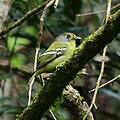| Piprites | |
|---|---|
 | |
| Black-capped piprites (Piprites pileata) | |
| Scientific classification | |
| Kingdom: | Animalia |
| Phylum: | Chordata |
| Class: | Aves |
| Order: | Passeriformes |
| Family: | Tyrannidae |
| Subfamily: | Pipritinae Ohlson, Irestedt, Ericson & Fjeldså, 2013 [1] |
| Genus: | Piprites Cabanis, 1847 |
| Type species | |
| Pipra pileata [2] Temminck, 1822 | |
Piprites is a genus of bird currently placed in the family Tyrannidae. Prior to 1971, the genus was placed in the family Pipridae; [3] its designation was initially changed based on morphological evidence, [4] and genetic evidence confirmed its placement in 2009. [5] In 2013, it was proposed that Piprites was to be placed in the unique family Pipritinae. [1] The proposition was declined by the Comité de Clasificación de Sudamérica, a part of the American Ornithological Society, and the proposed family was changed to be a unique subfamily of the genus. [6] The genus is composed of three species native to the neotropical realm, with distributions ranging from the Caribbean coast of Guatemala, Central America, and southeastern Argentina. [7]



